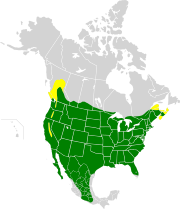The American rosefinches that form the genus Haemorhous are a group of passerine birds in the finch family Fringillidae. As the name implies ("haemo" means "blood" in Greek), various shades of red are characteristic plumage colors of this group. They are found throughout the North American continent.
The genus is not closely related to the Carpodacus rosefinches that are found in Europe and Asia.[2][3]
Systematics
There have been a number of rosefinch radiations. One of the first to split off were the ancestors of the North American species and diverged in the Middle Miocene (about 14–12 mya) from the proto-rosefinches.[4]
Within the genus the House Finch is the outgroup, meaning the Purple and Cassin's finches are more closely related to one another than either is to the House Finch.[5]
Species
The genus contains three species:[2][6]
| Common name | Scientific name and subspecies | Range | Size and ecology | IUCN status and estimated population |
|---|---|---|---|---|
| Cassin's finch | Haemorhous cassinii (Baird, 1854) |
western North America as far south as northern New Mexico and Arizona; also Southern California near Baja California.
|
Size: Habitat: Diet: |
LC
|
| Purple finch | Haemorhous purpureus (Gmelin, 1789) Two subspecies
|
Canada and the northeastern United States
|
Size: Habitat: Diet: |
LC
|
| House finch | Haemorhous mexicanus (Müller, 1776) |
North America from southern Canada to the Mexican state of Oaxaca
|
Size: Habitat: Diet: |
LC
|
References
- ^ "Fringillidae". aviansystematics.org. The Trust for Avian Systematics. Retrieved 2023-07-16.
- ^ a b Chesser, R. Terry; Banks, Richard C.; Barker, F. Keith (2012). "Fifty-third Supplement to the American Ornithologists' Union Check-list of North American Birds" (PDF). The Auk. 129 (3): 573–588. doi:10.1525/auk.2012.129.3.573. S2CID 198159113. Retrieved 2012-07-18.
- ^ Zuccon, Dario; Prŷs-Jones, Robert; Rasmussen, Pamela C.; Ericson, Per G.P. (2012). "The phylogenetic relationships and generic limits of finches (Fringillidae)" (PDF). Molecular Phylogenetics and Evolution. 62 (2): 581–596. doi:10.1016/j.ympev.2011.10.002. PMID 22023825.
- ^ Banks, Richard C.; Browning, M. Ralph (July 1995). "Comments on the Status of Revived Old Names for Some North American Birds" (PDF). The Auk. 112 (3). Berkeley, California: University of California Press: 633–648. JSTOR 4088679.
- ^ Smith, Brian Tilston; Bryson, Robert W.; Chua, Vivien; Africa, Lia; Klicka, John (2013-03-01). "Speciational history of North American Haemorhous finches (Aves: Fringillidae) inferred from multilocus data". Molecular Phylogenetics and Evolution. 66 (3): 1055–1059. doi:10.1016/j.ympev.2012.11.016. ISSN 1055-7903. PMID 23219607.
- ^ Gill, Frank; Donsker, David (eds.). "Finches, euphonias". World Bird List Version 5.2. International Ornithologists' Union. Retrieved 5 June 2015.








Recent Comments